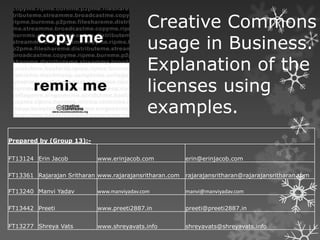Creative commons Group 13 SMM GLIM
- 1. Creative Commons usage in Business. Explanation of the licenses using examples. Prepared by (Group 13):- FT13124 Erin Jacob www.erinjacob.com erin@erinjacob.com FT13361 Rajarajan Sritharan www.rajarajansritharan.com rajarajansritharan@rajarajansritharan.com FT13240 Manvi Yadav www.manviyadav.com manvi@manviyadav.com FT13442 Preeti www.preeti2887.in preeti@preeti2887.in FT13277 Shreya Vats www.shreyavats.info shreyavats@shreyavats.info
- 2. Introduction About the company ? Creative commons is a NFP (Not-for-profit organization) which is headquartered in US. ? With the support of Center for the Public Domain, it was founded in 2001 by Lawrence Lessig, Hal Abelson, and Eric Eldred The main Idea ? The main idea is to encourage and embrace creativity. ? The creative work is restricted for usage to a limited audience because of the license clauses. ? Creative commons helps in resolving this by providing creative commons licenses. ? All rights reserved -> Some rights reserved ? A small clip from creative commons themselves explaining the idea of ?earning A sign in a restaurant where while sharing? only Creative Commons http://creativecommons.org/licenses/ Licensed music is played
- 3. Benefits of Creative Commons The traditional New-age open Creative commons licensing source concept licensing ?Allows you to ?Enables sharing to ?It withholds the protect your work enhance creativity advantages and at so that you can (by giving your the same time make money with away your work to overcomes the copy right others without drawbacks of protection. restrictions) traditional methods. ?But compromises ?But quite vary of a ?Thus it captures the on the restriction of strong sustainable best of both worlds sharing creative monetary business (The traditional works (which model. licensing and open others could have source). Is it that built upon great? otherwise and grow it multifold). Creative commons licensing Share creativity and allow Long-term benefits (like Monetary benefits (like in it to grow (like open source greater visibility and traditional method) concept) breakthrough innovations)
- 4. Layers of License ? Legal Code: Each license begins as a traditional legal tool, in the kind of language and text formats that most lawyers know and love. ? Human Readable: licenses available in a format that normal people can read ¡ª the Commons Deed (also known as the ¡°human readable¡± version of the license). ? Machine Readable: recognizes that software, from search engines to office productivity to music editing, plays an enormous role in the creation, copying, discovery, and distribution of works.
- 5. Type of License (1) ? Attribution CC BY: This license lets others distribute, remix, tweak, and build upon your work, even commercially, as long as they credit you for the original creation. ? Attribution-NoDerivs CC BY-ND: This license allows for redistribution, commercial and non-commercial, as long as it is passed along unchanged and in whole, with credit to you. ? Attribution-NonCommercial-ShareAlike CC BY-NC-SA: This license lets others remix, tweak, and build upon your work non-commercially, as long as they credit you and license their new creations under the identical terms.
- 6. Type of License (2) ? Attribution-ShareAlike CC BY-SA: This license lets others remix, tweak, and build upon your work even for commercial purposes, as long as they credit you and license their new creations under the identical terms. ? Attribution-NonCommercial CC BY-NC: This license lets others remix, tweak, and build upon your work non-commercially, and although their new works must also acknowledge you and be non- commercial. ? Attribution-NonCommercial-NoDerivs CC BY-NC-ND: This license is the most restrictive of our six main licenses, only allowing others to download your works and share them with others as long as they credit you, but they can?t change them in any way or use them commercially.
- 7. Some Popular Projects Using CC Khan Academy xkcd (CC BY-NC) (CC-BY-NC-SA) Wikipedia (CC BY- Stack Overflow SA, since June 2009) (CC BY-SA)
- 8. Who doesn?t use Creative Commons? ? Companies who hold onto their few innovations very tightly, and are often busy litigating instead of innovating for example....... ? Companies existing purely for monetary purposes. ? Companies whose competitive edge is based exclusively on their IP?s ? Companies like Apple.
- 9. How can businesses use it better? (1) Large corporate entities can use Creative Commons licensing to sharing knowledge, be more innovative and build better products and services. Creative Commons can help businesses build an audience of loyal customers by sharing knowledge and learning?s that add value to the existing products and services that their customers currently pay for Example: Company 37signals who have built a very successful business by sharing knowledge and being open with their customers.
- 10. How can businesses use it better? (2) Creative Commons also allows artists to control/restrict what people can do with their material so they can feel secure that their material can be freely distributed without being changed or remixed. So, artists can shared their work on web sites such as YouTube to gain exposure and popularity. Teachers and students can share their work beyond classrooms. Creative Commons enables people who are studying to further their education to collaborate with each other without the fear that their work will be used improperly or without acknowledgment. An individual can create an online presence by publishing their work and gaining recognition.
- 11. Limitation of Creative Common ?s Licenses Licenses are a blanket and Restrict only commercial generic coverage; They are activities. non-exhaustive. Bounded to release the Creative Common?s license work under Creative cannot be revoked. Commons.
- 12. Reference ? http://en.wikipedia.org/wiki/Creative_Commons ? http://creativecommons.org/licenses/ ? http://wiki.creativecommons.org/images/f/f7/BusinessM odelsforCreativeWorks.pdf ? http://creativecommons.org/extras/copyremix Thank You












